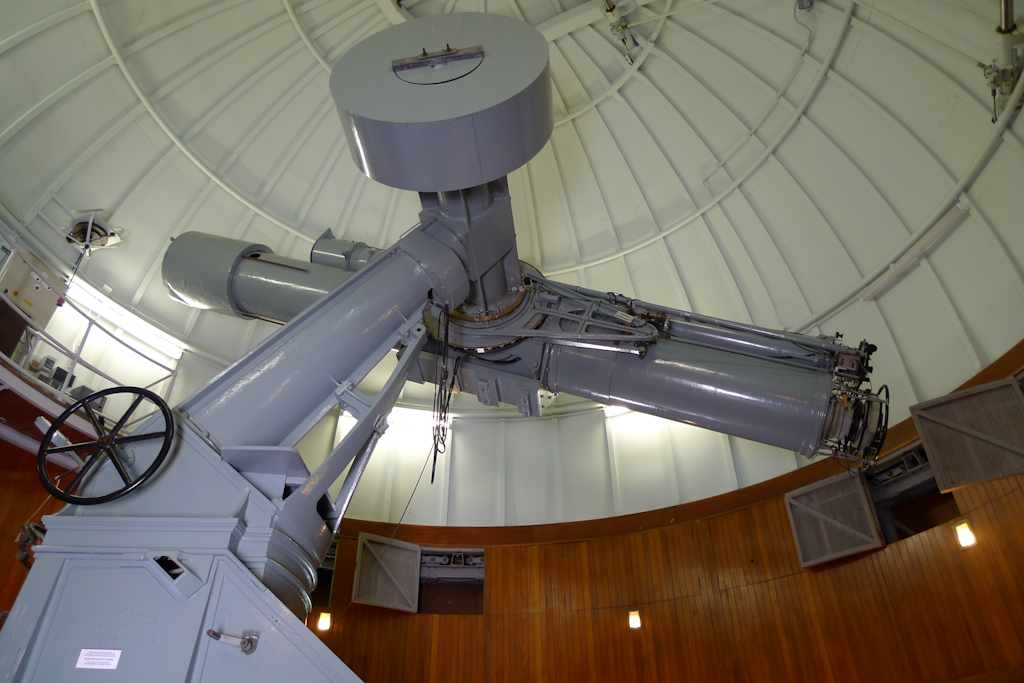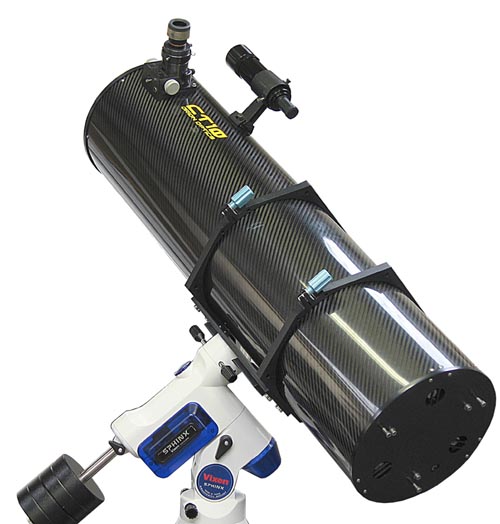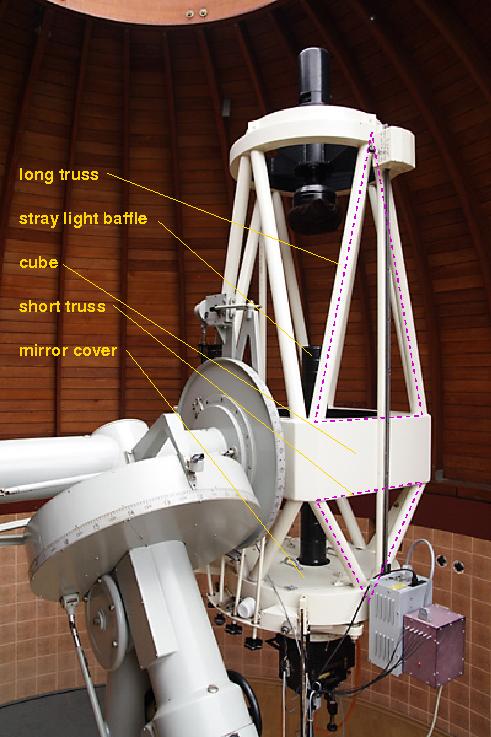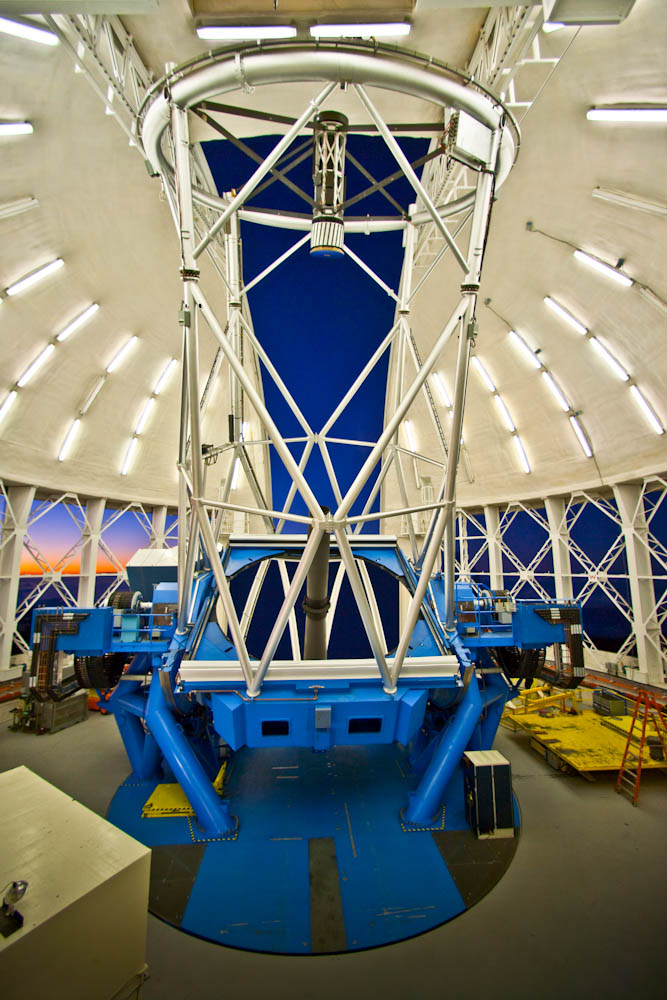| tubes and trusses |
|
The tube or trusses of a telescope must perform the task of holding the optical components at the correct separation and at the correct relative alignment, regardless of the orientation of the telescope on the sky. Smaller telescopes tend to use tubes and larger telescopes trusses - we shall look at each in turn.
tubes
Most amateur telescopes use tubes to mount the optics because they are simple, cheap and can be made stiff enough to hold small-aperture mirrors and lenses without becoming too heavy to mount. A tube also has the advantage of providing a closed optical system, which helps to reduce stray light (and hence improves image contrast) and protects the inner surfaces of the lenses and/or mirrors from dirt and dew. As shown in figure 40, tubes can be made from a number of different materials, including steel, aluminium, carbon fibre, fibreglass and plastic, with the ideal material being stiff, light-weight, cheap and possessing a low coefficient of thermal expansion. The latter property ensures that the distance between the optical components of a telescope does not alter significantly as the temperature changes, although this can usually be compensated for by refocusing.
There are two main disadvantages to using tubes. The first, which applies primarily to open-ended tubes such as used with Cassegrain telescopes, is that they are susceptible to tube currents, where the trapped volume of warm air in the tube mixes turbulently with the colder outside air, degrading the seeing. This is not such a problem with closed-ended tubes, such as used with refractors and Schmidt-Cassegrain telescopes, but even closed-tube telescopes are often fitted with fans and vents to bring the optics into thermal equilibrium with the surroundings as quickly as possible. The second disadvantage of tubes is that they cannot be used to mount really large optics - to retain rigidity, they simply become too heavy, placing too much strain on the telescope mounting.
| figure 40: |
Examples of different telescope tubes. Left: photograph of
the 26-inch Thompson Refractor at Herstmonceux, which has a
closed-ended steel tube. Right: photograph of a
10-inch Newtonian telescope with an open-ended carbon-fibre tube. Note
the fans and ventillation slots at the base of the primary mirror.
|


trusses
A truss is a rigid structural element which is usually made up of triangular shaped units. Triangles are used because each of a triangle's three internal angles are fixed by the side opposite it. Hence it is impossible to change the angle between two sides of a triangle without changing the length of the side opposite it. This means that if a load is applied anywhere on a triangle, its angles, unlike those of other shapes (like squares), will not change.
The most commonly used truss design in telescopes is the Serrurier truss, named after its inventor in 1935, the US engineer Mark Serrurier. The Serrurier truss is composed of eight individual trusses, four holding the primary mirror and four holding the secondary mirror. The two sets of four trusses are joined at the declination/altitude axis, in a structure generally referred to as the cube, as shown in the left-hand panel of figure 41.
| figure 41: |
Left:
Photograph
of the 0.6m Ostrowik telescope in Poland, which employs a Serrurier truss
design. Right: Photograph of the 8.1m Gemini North telescope on Hawaii.
|


The lengths of the short and long sets of trusses are selected so that they both flex by exactly the same amount, keeping the primary and secondary mirrors on the same optical axis regardless of the telescope orientation. In addition, when tipped over horizontally, the vertical pair of trusses oppose bending by gravity, while the horizontal pair form a parellogram with the top ring and cube (or the cube and primary mirror cell), thereby ensuring that the two mirrors always remain parallel to each other, maintaining optical alignment and hence image quality.
Almost all telescopes larger than ~1 m in aperture use Serrurier trusses, as only this design can provide a stiff yet light-weight structure to keep the mirrors aligned. Telescopes with Serrurier trusses are open, and hence they do not suffer from tube currents and are able to come into thermal equilibrium with their surroundings much more quickly than telescopes with tubes. The disadvantage of the open design is that the optics, particularly the upward-facing primary mirror, are exposed to the environment and hence must be covered when not in use and cleaned/re-aluminised regularly. The open design is also susceptible to stray light, although this can be alleviated to some extent through the use of baffles (see figure 41). Some large telescopes use a variant of the Serrurier truss, as shown in the right-hand panel of figure 41, where the cube is eliminated in order to minimise the thermal input into the light beam of the telescope (which is of importance for infrared observations).